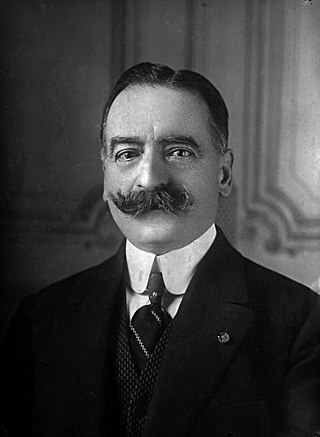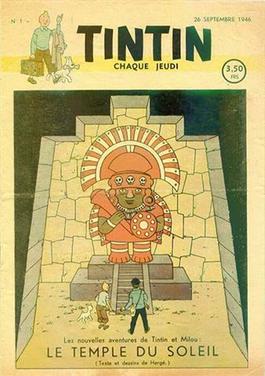History and profile
Zonneland was first published in 1920, [1] and by 1922 had 100,000 subscribers. It was a catholic magazine, directed and published by the Averbode Abbey. [1] It shared some elements with Petits Belges, but the French language version had less purely catholic contents and more stories and general information. Between 1929 and 1934, Petits Belges was replaced by a magazine for girls (Stella) and one for boys (Cadet). [2]
In 1930, the first of the long-running series of Vlaamse Filmpjes (complete stories of 32 pages, published every week or every two weeks) was inserted as a supplement to Zonneland. [3]
By 1935, Zonneland had dropped to 60,000 subscribers, while Petits Belges only was printed in 28,000 copies. In 1936, Father Daniel De Kesel became the new editor-in-chief, and started writing articles using the pen name "Nonkel Fons". He remained in charge until 1984. The magazines had to suspend publication between September 1943 and November 1944 due to the censoring and paper shortage during the war. In 1966, Zonneland had nearly 120,000 subscribers, and by 1976 this had increased to 135,000. [2]
Zonneland was initially aimed at all children aged 7 to 12, but later got more specifically targeted towards 10- and 11-years old children. For younger children Averbode started publishing Dopido (2-3 years, from 1990) Doremi (1-5 years, from 1965 on), Zonnekind (6-7 years, from 1958 on), and Zonnestraal (8-9 years, from 1966 on), while children between 12 and 15 got Top magazine (1973, replaced by iD in 1995 ), and the 16- and 17-years old were reached through Yell (1981). [2]
Well-known authors who published in Zonneland include Edward Poppe, John Flanders, Ernest Claes, and Leopold Vermeiren. Comics authors include Jan Waterschoot, Jeff Broeckx, Jean-Pol, Renaat Demoen, Gray Croucher, Berck, Buth, and François Craenhals. Petits Belges published some of the first works by Jijé.

René Goscinny was a French comic editor and writer, who created the Astérix comic book series with illustrator Albert Uderzo. He was raised primarily in Buenos Aires, Argentina, where he attended French schools, as well as lived in the United States for a short period of time. There he met Belgian cartoonist Morris. After his return to France, they collaborated for more than 20 years on the comic series Lucky Luke.

Quebec comics are French language comics produced primarily in the Canadian province of Quebec, and read both within and outside Canada, particularly in French-speaking Europe.

The Flemish Movement is an umbrella term which encompasses various political groups in the Belgian region of Flanders and, less commonly, in French Flanders. Ideologically, it encompasses groups which have sought to promote Flemish culture and the Dutch language as well as those seeking greater political autonomy for Flanders within Belgium. It also encompassed nationalists who seek the secession of Flanders from Belgium, either through outright independence or unification with the Netherlands.
Joseph Gillain, better known by his pen name Jijé, was a Belgian comics artist, best known for being a seminal artist on the Spirou et Fantasio strip and the creator of one of the first major European western strips, Jerry Spring.

Belgians are people identified with the Kingdom of Belgium, a federal state in Western Europe. As Belgium is a multinational state, this connection may be residential, legal, historical, or cultural rather than ethnic. The majority of Belgians, however, belong to two distinct linguistic groups or communities native to the country, i.e. its historical regions: Flemings in Flanders, who speak Dutch; and Walloons in Wallonia, who speak French or Walloon. There is also a substantial Belgian diaspora, which has settled primarily in the United States, Canada, France, and the Netherlands.

Willy Vandersteen was a Belgian creator of comic books. In a career spanning 50 years, he created a large studio and published more than 1,000 comic albums in over 25 series, selling more than 200 million copies worldwide.

Charles, 1st Count de Broqueville was the prime minister of Belgium, serving during World War I.
Éditions Dupuis S.A. is a Belgian publisher of comic albums and magazines.

Belgian comics are a distinct subgroup in the comics history, and played a major role in the development of European comics, alongside France with whom they share a long common history. While the comics in the two major language groups and regions of Belgium each have clearly distinct characteristics, they are constantly influencing one another, and meeting each other in Brussels and in the bilingual publication tradition of the major editors. As one of the few arts where Belgium has had an international and enduring impact in the 20th century, comics are known to be "an integral part of Belgian culture".

Tintin was a weekly Franco-Belgian comics magazine of the second half of the 20th century. Subtitled "The Magazine for the Youth from 7 to 77", it was one of the major publications of the Franco-Belgian comics scene and published such notable series as Blake and Mortimer, Alix, and the principal title The Adventures of Tintin. Originally published by Le Lombard, the first issue was released in 1946, and it ceased publication in 1993.

Averbode Abbey is a Premonstratensian abbey situated in Averbode, in the municipality Scherpenheuvel-Zichem, in the Archdiocese of Mechelen-Brussels in Belgium. It was founded about 1134, suppressed in 1797, and reestablished in 1834. Throughout the 20th century the abbey press was a leading children's publisher in Belgium. The church's building is a peculiar synthesis of Baroque and Gothic, with Renaissance ornament details, dominating the monastery complex. The whole structure was built of iron sandstone from Langdorp and white sandstone from Gobertange between 1664 and 1672, after a design by the Antwerp architect Jan Van den Eynde II.

Le Petit Vingtième was the weekly youth supplement to the Belgian newspaper Le Vingtième Siècle from 1928 to 1940. The comics series The Adventures of Tintin first appeared in its pages.
François Craenhals was a Belgian comics artist best known for the comic series Chevalier Ardent and Les 4 As.

Uitgeverij Averbode is a Belgian publisher of books, comics, and magazines. The company is located in Averbode and is part of the Averbode Abbey. It has changed its name a few times since its foundation in 1877.

HP/De Tijd is a Dutch language monthly opinion magazine. Its editorial offices are in Amsterdam, Netherlands. Alongside De Groene Amsterdammer, Vrij Nederland and Elsevier, it is one of the most influential Dutch opinion magazines.
Renaat Demoen was a Belgian illustrator and comics creator. He is most associated with the children's magazines of De Goede Pers, among them Zonneland.

Blondin et Cirage is a Belgian humoristic adventure comic strip by Jijé created in 1939 for the Catholic children's magazine Petits Belges. The comic was also published in its Flemish counterpart Zonneland, initially under the name Wietje en Krol, later as Blondie en Blinkie. It stars two boys, Blondin – who is white – and Cirage – who is black.
Elza Severin was a Belgian artist.













